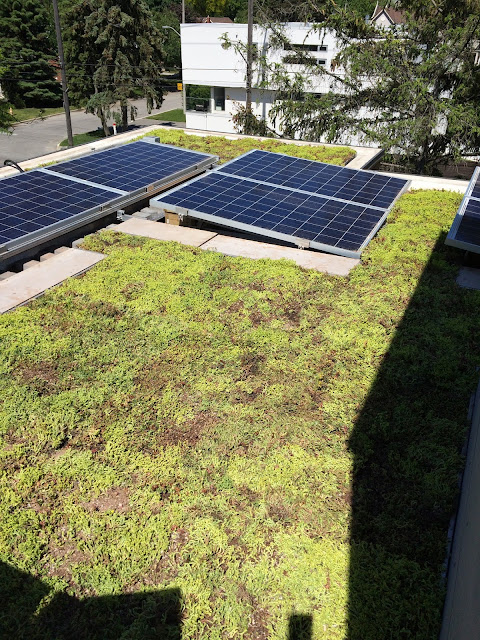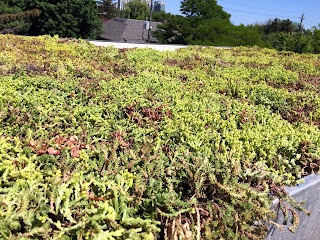Shrubs In Tubs - Part 4 - Installation and Planting
The planting of the shrubs is a bit tricky because I did not have access to a mechanical hoist.
Friend Lino, the framer for the houses behind ours, did give us a lift with the Load Distribution Pads, and the two planters, but he was away on the day when I finished the installation. Lino has a zoom boom and is very gracious when we needed a hoisting hand.
The installation of the shrubs into the tubs was fundamentally the same as on the roofs.
Two layers of drainage material were fitted to the base.
It was then covered with a layer or two of the felted water storage material, cut to suit the geometry of the tub or the planter.
The tailoring of the storage layer to accommodate the circular geometry of the tubs means that there is quite a large area of overlapping material. More storage capacity.
The containers were then filled "3/4" with the same mineralized growing medium as was used on the roofs. It is known as XTerr from Xeroflor.
The last 1/4 was a mixture of growing medium and "triple-mix", mainly because I had he triple-mix available (left over from last season) and I wanted to add more basic nutrients to the immediate growing zone.
Plantings.
There were chosen for their tolerance of full sun, a bit of heat, and modest water.
The two planters received a juniper each. It is hoped that these will grow up a bit, but mostly sideways. The tag said 1.5' (0.5m) high and about 3' (1m) wide.
The following material was planted into tubs.
- Pom-Pom Pine - Pinus sylvestris '(pom pom)' - ours has only one pom so it is not really a pom pom.
- Cascading White Pine - pinus strobus that may have been trained in its youth
- Two Tree Peonies- Paeonia suffruticosa are about a foot high now, but we have higher hopes.
- Climbing Hydrangea - I have added a trellis of bamboos to provide a some height to which it can aspire.
Irrigation.
I have added a complete drip irrigation system, accessible from ground level. It is a Rain Bird Gardener's Drip Kit from Canadian Tire, about $60 (2015). I added a few drippers and a second circuit to support the climbing hydrangea with RainBird pieces from "Lowes". Lowes has a good selection of individual drip irrigation components so you don't have to buy complete kits each time you want another pressure reduction valve.
The climbing hydrangea has multiple drippers because it needs more water than the others. As a rule they all get watered on the same frequency as the rest of our garden.
I have added a complete drip irrigation system, accessible from ground level. It is a Rain Bird Gardener's Drip Kit from Canadian Tire, about $60 (2015). I added a few drippers and a second circuit to support the climbing hydrangea with RainBird pieces from "Lowes". Lowes has a good selection of individual drip irrigation components so you don't have to buy complete kits each time you want another pressure reduction valve.
The climbing hydrangea has multiple drippers because it needs more water than the others. As a rule they all get watered on the same frequency as the rest of our garden.
 |
| West Trough |
 |
| South Trough |
 |
| South Trough |
 |
| South Trough |
 |
| South Trough |





















